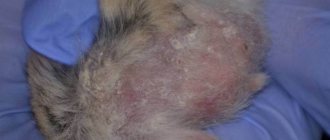- home
- Acquisition
07.04.2018
When purchasing a cute rodent as a pet, people do not realize that the hamster is a dangerous carrier of diseases. Diseases that are transmitted from animals to humans can be prevented. To do this, follow the basic rules for keeping the animal and periodically inspect it for signs of disease.
Unpleasant surprises from nature
Many of us truly love animals. We perceive our pets as family members, often not really thinking about our own safety. But the idyll can be destroyed if minimal precautions are not taken. It is naive to believe that the tailed inhabitants of our apartments are one hundred percent protected from all kinds of diseases. They are by no means isolated from the environment. Even after an ordinary walk, they can bring some kind of “sore” into the house, which can cause a lot of trouble not only for the pet, but also for you and your household. And if you are going out of town, remember that only vaccinated animals can be taken out into the wild, otherwise, when faced with their wild counterparts, our pets can become a source of disease for us.
Lichen
The causative agent of the disease is a pathogenic fungus. Hamsters can be carriers of ringworm and shingles, which can be transmitted to humans.
In domestic rodents, the disease manifests itself with the following symptoms:
- loss of appetite;
- inflammation of the affected skin area;
- rash;
- hair loss;
- the formation of a rough crust on the skin.
Since lichen is quickly transmitted by touching a sick animal, it and all objects that have been in contact with the rodent must be isolated from children and other family members.
Symptoms of the disease do not disappear on their own and require mandatory medical attention.
The course of treatment for lichen in hamsters involves the use of external disinfectants and antifungal drugs.
For internal use, medications are prescribed that restore the body's microflora and strengthen the pet's immunity.
You can treat the affected areas of your pet’s body with medications only using thick gloves.
Speckled skin
Microsporia or ringworm is one of the most common skin diseases of animals. When people become infected from them, people also get sick: small spots appear on the skin, covered with gray scales; there can be from two to a hundred of them on the human body. The causative agent of microsporia also affects the hair, so sometimes during treatment the head has to be shaved, which is very unpleasant for the patient. If you notice even a slight redness in the shape of a circle or ring, do not be lazy - go to a dermatologist. If time is lost, curing the disease will be much more difficult.
What can you get infected from hamsters?
Miniature creatures are carriers of several infections transmitted to humans.
The main diseases of hamsters dangerous to humans:
- Listeriosis is a disease that negatively affects the nervous system of animals and humans. In the initial stages there are no symptoms.
The main signs of a pet infection:
- Loss of balance when running.
- Apathy and drowsiness.
- Deterioration or lack of appetite.
- Fever.
At an early stage, listeriosis is easily treatable. In severe cases, the disease leads to the death of the pet.
The causes of infection are:
- Poor nutrition.
- Violation of the temperature regime in the cage.
- Insufficient home hygiene and improper care.
- Toxoplasmosis is a disease that poses a particular danger to pregnant women. The entry of infection into the body of a pregnant woman causes various pathologies of the fetus. In addition to hamsters, you can become infected with toxoplasmosis through contact with a cat or raw meat. Transmitted through pet feces and secretions.
- Tuberculosis is a dangerous disease of the respiratory tract. A pet can become infected by airborne droplets from humans.
Symptoms do not appear immediately. At first the animal seems absolutely healthy. The disease is manifested by loss of appetite, rapid weight loss and apathy. It is quite difficult to cure a hamster from tuberculosis. In most cases, it dies within a few days.
- Tularemia is a disease that affects the lymph nodes, skin and other parts of the body. It is asymptomatic. Your hamster can become infected through contaminated water or food. The disease is transmitted to humans through physical contact. Sick animals are euthanized and the premises are thoroughly disinfected.
- Ringworm affects the skin of the body.
Main symptoms of the disease:
- Hair loss.
- Formation of a crust on the affected areas.
- Itching.
- Anxiety.
When transporting the animal, it is recommended to use gloves and disinfect the room, cage and objects with which the hamster has been in contact.
- Parasites are common sources of disease. Transmitted through unprocessed food and low-quality fillers. A person can become infected through physical contact with an animal.
Diagnosing parasites at home is difficult. Symptoms are often similar to other diseases.
- Lymphocytic choriomeningitis affects the brain and blood vessels of the rodent. The disease is manifested by apathy, lack of appetite and convulsions. The disease is dangerous for humans.
- Various diseases of the gastrointestinal tract.
Most diseases are transmitted from hamsters to humans through physical contact. Before getting a pet, it is important to know what you can get from a hamster.
"Dogs can be biting..."
The main “reservoir” of the rabies virus is dogs, cats, wild animals, especially foxes. A sick animal behaves unusually: a domestic pet can become aggressive and refuse water and food, and vice versa, a wild animal is not afraid of people and comes out to them. To prevent rabies, pets must be vaccinated. Infection of a person occurs when a sick animal bites or its saliva gets on the mucous membranes and damaged skin, so if you are bitten by a dog or any other animal, the first thing you need to do is wash the wound with plenty of soap and water. There is no need to bandage or clamp the wound - the flowing blood will wash it away from the animal's saliva. But if a large blood vessel is bitten, this method is not applicable. And most importantly, if you are bitten by an animal, immediately consult a doctor at the emergency room at your place of residence! You can forget about the painful forty injections in the stomach - the new generation vaccines are injected into the shoulder and only six times. It should be remembered that rabies is a fatal disease, but timely vaccination actually prevents its development.
Can cats or dogs get the disease from a hamster?
How dangerous are hamsters for other pets? The presence of infectious diseases in rodents is not a cause for concern for owners of cats, dogs and other animals. In most cases, the disease is not transmitted to other animals. The exception is mixing the blood of a healthy and sick animal. The situation is possible if there are wounds.
It should be remembered that cats and dogs are also carriers of various diseases. It is necessary to take care of the health of all pets.
Dangerous water
Leptospirosis is an acute infectious disease that affects both people and animals. Outbreaks of leptospirosis occur mainly in the summer. The main way leptospirosis spreads is through water. When traveling out of town, try to avoid staying near livestock farms or pastures. The cause of the disease can be the consumption of water from open sources, since animals that carry leptospirosis can introduce leptospira into the water along with saliva and urine. Small forest lakes and ponds with stagnant water, which are often natural foci of leptospirosis, are not suitable for washing and swimming. The causative agent of the disease can enter the human body through damaged skin and mucous membranes. The digestive tract can also be the “gate of entry” for infection. If, despite all precautions, you have chills, a sharp rise in temperature, headaches and muscle pain, or inflamed eyes, you should immediately consult a doctor.
Lesions causing disturbances in the functioning of the gastrointestinal tract
The main disorders of the human gastrointestinal tract transmitted from hamsters are:
- salmonellosis – characterized by severe intoxication of the human body;
- campylobacteriosis – accompanied by disruption of the stomach;
- hymenolepidosis – characterized by convulsive, fainting states, dizziness, nausea.
The causes of the development of such diseases in animals are:
- unsanitary conditions of detention;
- constant contamination of feed;
- rare change of filler.
Caution – toxoplasmosis!
Humans can be infected with toxoplasmosis by dogs, cats, rabbits, as well as ornamental, singing and farm birds. In animals, the pathogen is excreted in feces and urine, and mucus from the nose. People become infected mainly through contaminated foods. Once in the human body, the pathogen spreads through the bloodstream, affecting the brain, eyes, spleen, liver, and lymph nodes. Acute toxoplasmosis is usually accompanied by fever, headache and muscle pain. Chronic can last for years and is expressed in low-grade fever, irritability, decreased visual acuity, memory and performance. Prevention of the disease consists of identifying and treating sick animals, which must be periodically examined. The most important measure is washing hands after contact with animals, as well as heat treatment of meat and dairy products.
Choriomeningitis
In hamsters the disease has no obvious symptoms. In some cases, there may be a decrease in activity and weight loss. But choriomeningitis poses a serious threat to human health.
This virus can cause encephalitis, meningitis, complex swelling of the lymph nodes, and symptoms of acute rotavirus infection.
The chances of recovery with proper treatment are high. Fatalities are extremely rare. Infected rodents spread the virus through saliva, urine and feces.
Choriomeningitis can also be transmitted from a pregnant woman to her child. The virus can cause miscarriage, stillbirth, hydrocephalus and developmental defects.
Disease on bird rights
Indoor birds (budgies, canaries and other small songbirds) can be a source of infection with psittacosis (pneumochlamydia). People who usually have constant contact with birds get it. When infected at home, family outbreaks can occur. Infection occurs by airborne droplets - when particles of bird feces are inhaled with dust while cleaning cages. The disease usually occurs 5–10 days after an infected bird appears in the house. If your feathered pet has been living with you for several months, then most likely it is healthy and infection is unlikely (if during this time there has been no contact with other birds). A sick person develops chills, headache and muscle pain, an increase in body temperature to 38-40 degrees, a dry cough and sore throat. On the fifth to seventh day, chest pain, shortness of breath, cough with bloody mucous sputum, and signs of pneumonia appear. A person suffers from insomnia and dizziness. If you do not consult a doctor in time, subsequent relapses and the disease may become chronic. The danger of the disease should not be underestimated, therefore, when the first signs of illness appear, you should immediately see a doctor.
Preventive measures
To ensure that hamsters do not transmit diseases dangerous to humans to their owner, certain rules should be followed. These include:
- balanced nutrition for pets;
- the use of vitamin-mineral complexes in their diet;
- absence of drafts in the place where the cage is installed;
- Carrying out frequent cage cleaning and disinfection measures;
- use of disposable rubber gloves during daily inspections of animals and during cleaning.
It is extremely important to monitor the condition of your hamster. If he loses his appetite, pus appears in his eyes, diarrhea, there is weight loss, he becomes restless, his fur begins to fall out or become matted and hang in clumps, most likely something is wrong with him. At the first signs of poor health, the animal must be taken to the veterinarian.
First, vaccinations...
If you notice any of the signs described above, do not rush to make a diagnosis yourself: even doctors never make a final verdict without the results of laboratory tests. It is better to immediately contact specialists, since it is always easier to get rid of any disease in the early stages. However, you need to be prepared for the fact that treatment can last from several weeks to months. In severe cases, hospitalization cannot be avoided. The best infection prevention is knowledge. Knowing that four-legged friends can be sources of very unpleasant diseases, it is wiser to prevent infection. If you pick up a dog or cat on the street, be sure to take it to the vet. He examines the animal for diseases, “illuminates” it with a fluorescent lamp to find out if there is microsporia, and gives the necessary vaccinations. Only then can you fearlessly introduce the foundling to your household. If the animal is sick, try to cure it; if the case is severe, it is better to euthanize - it will be more humane. But under no circumstances throw you out onto the street! After all, it becomes a source of infection for other people. And please practice good personal hygiene.
Prevention of diseases in hamsters
Good care and a nutritious diet are the main factors that will help maintain the health of the Djungarian hamster at the proper level. The owner must examine the pet every day and not ignore signs of illness.
How to protect your hamster from diseases:
- Maintain the correct microclimate - eliminate overheating, cold, dampness, drafts and temperature changes.
- Clean the cage regularly - change the filler, wash the equipment.
- Ensure safety in your pet's home and beyond.
- Keep new hamsters in quarantine for 2 weeks.
- Limit contact of the dwarf with other domestic animals that can be carriers of infectious diseases.
Djungarian hamsters need extra care as they have poor health. However, with good care, animals can live for about 3 years. The main thing is not to ignore the first signs of illness and immediately seek veterinary help.











